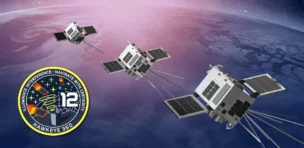Another day, another mega LEO constellation.
Last week, Logos Space filed an FCC application for a proposed satcom network consisting of 3,960 satellites—yet another addition to the LEO mega constellation party.
The announcement comes during a busy week of LEO investment and market demand news.
Logos 101: Logos–meaning ‘speech’ or ‘reason’ in Greek—was founded by Milo Medin, the former VP of access services at Google.
- At an altitude of 870-925 km, Logos’ system will sit above Starlink/Kuiper but below OneWeb/Telesat.
- With 3,960 satellites, the constellation is on the high end of proposed systems, larger than Amazon’s Kuiper, Telesat’s Lightspeed, and OneWeb’s network.
- Ka-, Q/V-, and E-band frequencies will be employed, with the higher frequencies being reserved for inter-satellite links. The network will also feature extremely narrow beams starting at 20 MHz bandwidth, increasing their resistance to interference.
Can Logos differentiate itself? Designing satellite systems requires balancing trade-offs aligned with a company’s target customers and specific use cases. Logos’s focus is on resilience and a dual-use system, emphasizing enterprise customers. Logos satellites will:
- Communicate with user terminals at high elevation angles to minimize interference
- Are built with a software-defined network control system
- Provide enhanced satellite diversity through multiple altitudes and inclinations
- Are designed to operate in a contested spectrum environment through narrow beams, different waveforms, and the ability to jump across multiple GHz of spectrum
Can the Market Support Another Mega Constellation?
The satcom market that keeps on growin’: Since the emergence of LEO constellations, there has been no shortage of high-stakes debates over the potential size of the satcom market. Is the market big enough for more than one mega constellation? Can the economics justify cost-competitive pricing in international markets? Will quality still be meh?
Starlink’s hockey stick growth this year is demonstrating that the market for LEO constellations (for both civilian and defense customers) is very large.
- In 2023, the Starlink user base grew by 1.3M, reaching a total of 2.3M users.
- In the first nine months of 2024, the Starlink user base accelerated, growing by 1.7M customers to 4M. The network is on pace to blow past 2M user adds this year.
Demand surge: The high-speed connectivity offered by LEO constellations (compared to the so-so speeds of GEO) has significantly expanded the addressable satcom market.
For the DoD, the demand is insatiable.
Image: Space Force
The DoD is reportedly upping its commercial satellite service contract over the next four years from $900M to a staggering $13B *feel free to do a double take on that number, as I did*.
What has become abundantly clear is that once warfighters get a taste of high-speed internet from anywhere in the world, the capability jumps to near the top of wish lists.
This is one of the markets Logos will be targeting. The government has an obligation to diversify its vendors, potentially offering Logos a small opening to capitalize on the market growth.
Warning ⚠️: Rivada offers a cautionary tale. Similar to Logos, Rivada came out of left field in 2022 with big ambitions for a 600-satellite constellation. They quickly turned around and announced a $2.4B mega contract with Terran Orbital to build the birds. But investor appetite for the Rivada plans has been lukewarm, and the project has since been in a holding pattern.
LEO constellations are expensive. Amazon’s 3,236-bird Kuiper’s constellation will cost roughly $10B to develop. With the Logos constellation projected to be larger than Kuiper, they will need to raise a whole lot of capital.
Satcom investment continues to rise: In addition to the Logos FCC application, three major satcom investment decisions were also announced in the last week.
- The European Commission awarded a 12-year contract for the IRIS² system, a 290-satellite constellation. The contract was awarded to the SpaceRISE consortium, consisting of most European defense primes. The project may cost upwards of €10B.
- Apple announced a $1.5B investment in a new Globalstar constellation. Apple has secured 85% of Globlastar’s current and future capacity, highlighting the importance of satellite-enabled services in the mobile business.
- Australia canceled its approximately $5B GEO communications project, citing a shift in technology that has increased the appeal of LEO and MEO solutions.
There are more than ten proposed large LEO constellations in development, aiming to compete with Starlink, OneWeb, and soon-to-be-launched Kuiper for a slice of the satcom market. It remains to be seen how many constellations the market can support and who will have the capital to bring the hundreds—or, in some cases, thousands—of satellites to orbit.




